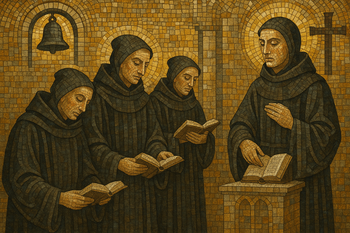Receive God's Love, Proclaim the Greatness of the Lord, Serve Joyfully & Make Missionary Disciples of Jesus Christ
-

LITURGY CORNER
The Divine Office + Morning Prayer
Generally the first of the Liturgy of the Hours that most people pray is Morning Prayer (historically known as Lauds). The liturgy begins with this simple dialogue:
Lord, open our lips.
And we shall praise your name.
This dialogue can be followed by the invitatory psalm and then a hymn.
Following the hymn is the first of the proper psalms, a canticle, and then another psalm. Both of these terms are related to song forms of prayer. The difference is their source. Psalms come from the book of psalms while canticles are poems intended for singing that occur anywhere else in the bible. The manner of presentation of these texts can vary greatly. The psalms usually have an antiphon (a simple refrain) that is said at the beginning and end of the psalm. In contrast to the responsorial psalm of Mass these psalms include a Glory be to the Father. The verses usually alternate between two groups of people (left vs right) or between a leader and the rest of the people.
After the second psalm there is a scripture reading, and then a short responsory and then a Gospel Canticle. For morning prayer the Canticle is known as the Benedictus which comes from the New Testament when John the Baptist’s father’s mouth is opened and he proclaims praise to God and the promise of the Messiah. This is followed by prayers and intercessions, the Lord’s prayer, and then a closing doxology.
Which psalms, canticles, and readings vary from day to day depending on the liturgical season, day of the week, and sequence of weeks. This liturgy is a great way that we can dedicate our day to God while also uniting our voice with countless numbers of people across the globe and throughout time.
RINCÓN DE LITURGIA
El Oficio Divino + Oración de la Mañana
Generalmente, el primer rezo de la Liturgia de las Horas que la mayoría de la gente reza es la Oración de la Mañana (históricamente conocida como Laudes). La liturgia comienza con este sencillo diálogo:
Señor, abre nuestros labios.
Y alabaremos tu nombre.
Este diálogo puede ir seguido del salmo invitatorio y luego un himno.
Después del himno se canta el primero de los salmos propios, un cántico y luego otro salmo. Ambos términos están relacionados con las formas de oración cantadas. La diferencia radica en su origen. Los salmos provienen del libro de los salmos, mientras que los cánticos son poemas destinados a ser cantados que aparecen en cualquier otra parte de la Biblia. La forma de presentación de estos textos puede variar considerablemente. Los salmos suelen tener una antífona (un estribillo simple) que se recita al principio y al final del salmo. A diferencia del salmo responsorial de la misa, estos salmos incluyen un Gloria al Padre. Los versículos suelen alternarse entre dos grupos de personas (izquierda vs. derecha) o entre un líder y el resto del pueblo.
Después del segundo salmo, se lee una lectura bíblica, seguida de un breve responsorio y un cántico evangélico. Para la oración de la mañana, el cántico se conoce como Benedictus, que proviene del Nuevo Testamento, cuando el padre de Juan el Bautista abre la boca y proclama alabanzas a Dios y la promesa del Mesías. A esto le siguen oraciones e intercesiones, el Padre Nuestro y una doxología final.
Los salmos, cánticos y lecturas varían a diario según el tiempo litúrgico, el día de la semana y la secuencia de semanas. Esta liturgia es una excelente manera de dedicar nuestro día a Dios y, al mismo tiempo, unir nuestra voz con la de innumerables personas de todo el mundo y de todos los tiempos.